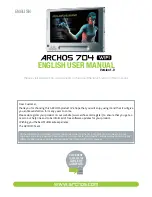
500520-N - 8500W PORTABLE INVERTER GENERATOR
OPERATION
22
CAUTION
While charging a device do not place on the exhaust side of the
generator. Extreme heat caused by exhaust can damage the
device, and cause a potential fire hazard.
Battery Charging
1. Before connecting the battery charging cable (included) to a
battery that is installed in a vehicle, disconnect the vehicle
battery ground cable from the negative (–) battery terminal.
2. Plug the battery charging cable into the 12V DC receptacle of
the generator.
3. Connect the red (+) battery charger lead to the red (+) battery
terminal.
4. Connect the black (–) battery charger lead to the black (–)
battery terminal.
5. Start the generator.
Important:
The 12V DC outlet is ONLY to be used with the
supplied 12V DC battery charging cable. The 12V DC output is
unregulated and will damage other 12V DC products. When using
the 12V DC outlet, turn the Economy mode switch to the “OFF”
position. Be sure all electric devices including the lines and
plug connections are in good condition before connection to the
generator.
CAUTION
Do not start the vehicle while the battery charging cable is
connected and the generator is running. It will not give the
battery a boost of power. The vehicle or the generator may
be damaged. Charge only vented wet lead acid batteries.
Other types of batteries may burst, causing personal injury or
damage.
NOTICE
Be sure all electric devices including the lines and plug
connections are in good condition before connection to the
generator.
Stopping the Engine
1. Turn off and unplug all electrical connected loads. Never start
or stop the generator with electrical devices plugged in or
turned on.
2. Let the generator run at no-load for several minutes to
stabilize internal temperatures of the engine and generator.
3. Press the engine switch to the “OFF” position.
4. Turn the fuel valve to the “OFF” position.
Important:
Always ensure that the fuel valve and the engine
switch are in the “OFF” position when the generator will not be
used for an extended period of time.
NOTICE
If the engine will not be used for a period of two (2) weeks or
longer, please see the Storage section for proper engine and
fuel storage.
Operation at High Altitude
The density of air at high altitudes is lower than at sea level.
Engine power is reduced as the air mass and air-fuel ratio
decrease. Engine power and generator output will be reduced
approximately 3½% for every 1000 ft. of elevation above sea level.
At high altitudes increased exhaust emissions can also result due
to the increased enrichment of the air fuel ratio. Other high altitude
issues can include hard starting, increased fuel consumption and
spark plug fouling.
To alleviate high altitude issues other than the natural power
loss, CPE can provide a high altitude carburetor main jet. The
alternative main jet and installation instructions can be obtained
by contacting our Technical Support Team. Installation instructions
are also available in the Technical Bulletin area of the CPE website.
Summary of Contents for 500520-N
Page 29: ...500520 N 8500W Portable Inverter Generator Specifications 29 Parts Diagram...
Page 31: ...500520 N 8500W Portable Inverter Generator Specifications 31 Part Number Description Qty...
Page 32: ...500520 N 8500W Portable Inverter Generator Specifications 32 Engine Parts Diagram...
Page 34: ...500520 N 8500W Portable Inverter Generator Specifications 34 Part Number Description Qty...
Page 35: ...500520 N 8500W Portable Inverter Generator Specifications 35 Wiring Diagram...















































